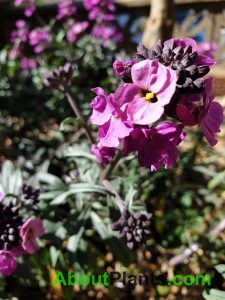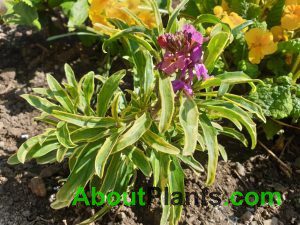Wallflowers are plants that may be classed as annuals (within one year completing the full life cycle from seed germination to the production of new seeds and then withering away completely), biennials (plants that have a 2 year life cycle, usually growing stem, roots and leaves in the first year, followed by natural regression and then regrowth in the second year to flower and seed before withering away) or perennials (those that regrow year on year without the need to reseed, tending to flower in the summer months and regress in late autumn and winter, to begin the process again in springtime).
Other examples of annuals are: peas, lettuce, corn.
Other examples of biennials are: carrot, Sweet William, onions, parsley, fennel.
Other examples of perennials are: hibiscus, dahlia.
Wallflowers are called Erysimum. There is a wide variety of wallflowers which all belong to the cabbage (Brassicaceae) family or genus. There are two examples shown in the images below.


The first example is the very popular Erysimum Bowles Mauve. The first two pictures show this variety. This is the choice of many gardeners in the British Isles because it is a hardy perennial that can produce flowers from spring right through to the end of summer in delightfully large clumps.
The second variety a smaller variety of perennial wallflower, Erysimum Linifolium Variegatum Peach, which produces beautiful peach and purple coloured flowers throughout the spring and summer. This is shown in the third picture.

This particular variety is a smaller, more compact wallflower. Even without the flowers, this plant provides interest and colour in the garden because it has beautifully striped (variegated) leaves. Wallflowers are popular flowers which attract insects and bees, which really love them.
Growing Wallflowers
Wallflowers like to be grown in full sun but will tolerate partial sun and some even more shady conditions. Wallflowers are mat forming and the perennial varieties are evergreen. Wallflowers like to have well drained soil which has been prepared with good organic fertiliser to help the roots spread and to improve water retention in the soil. Some wallflowers will even do well in poor soil conditions, so always check the individual variety’s instructions. Wallflowers can be propagated from seed. The seeds can be either sown directly into the ground or in bedding trays. Either way, the plants need to be sown at about half an inch in depth but sparsely in rows with about a foot between each row of seeds.
Transplanting
When large enough to handle for transplanting, pot up in individual pots. When the bedding plants are about 6 inches tall pinch the top shoots in order to encourage wider spread in the plant. When planting out these bedding plants in the garden, keep a space of 12 inches around the plant to encourage maximum growth. These bedding plants are best planted in late summer right up until the end of October. If you buy plants from a garden centre, the best time to plant is in spring. Make sure that the plant pots are well soaked before preparing a hole large enough to accommodate the root system. The soil can be prepared with good organic fertiliser to encourage vigorous growth. Position the plant so that is about half an inch below the final soil level. Water regularly throughout the first year to encourage growth until the plants are well established and thriving.
Care and Maintenance of Wallflowers
Feed with additional fertiliser each spring. Wallflowers are plants which keep on giving. The perennial plants take about 3 to 5 years to achieve full maturity, but cuttings can be taken after the first year. Take the cuttings by just cutting about 4 inches in length below a leaf node. It’s in best to plant these cuttings in pots which allow for individual growth. Cover the pots with a plastic bag or place in a propagator to root in good light but remember that direct sunlight could cause young leaves to shrivel on the stem. Water to ensure the soil is kept moist, but never waterlogged. When the young plants have developed from the cuttings, plant out in flower beds or patio pots. They make excellent herbaceous border plants and because of the different varieties will grow to different sizes ranging from 12 inches to about 30 inches in height. According to variety they will spread from about 12 inches to around 36 inches. Deadhead flowers and lightly prune after flowering to keep the flowers coming. Wallflowers provide beautiful displays in any garden and also provide beautiful scent particularly during balmy summer evenings.